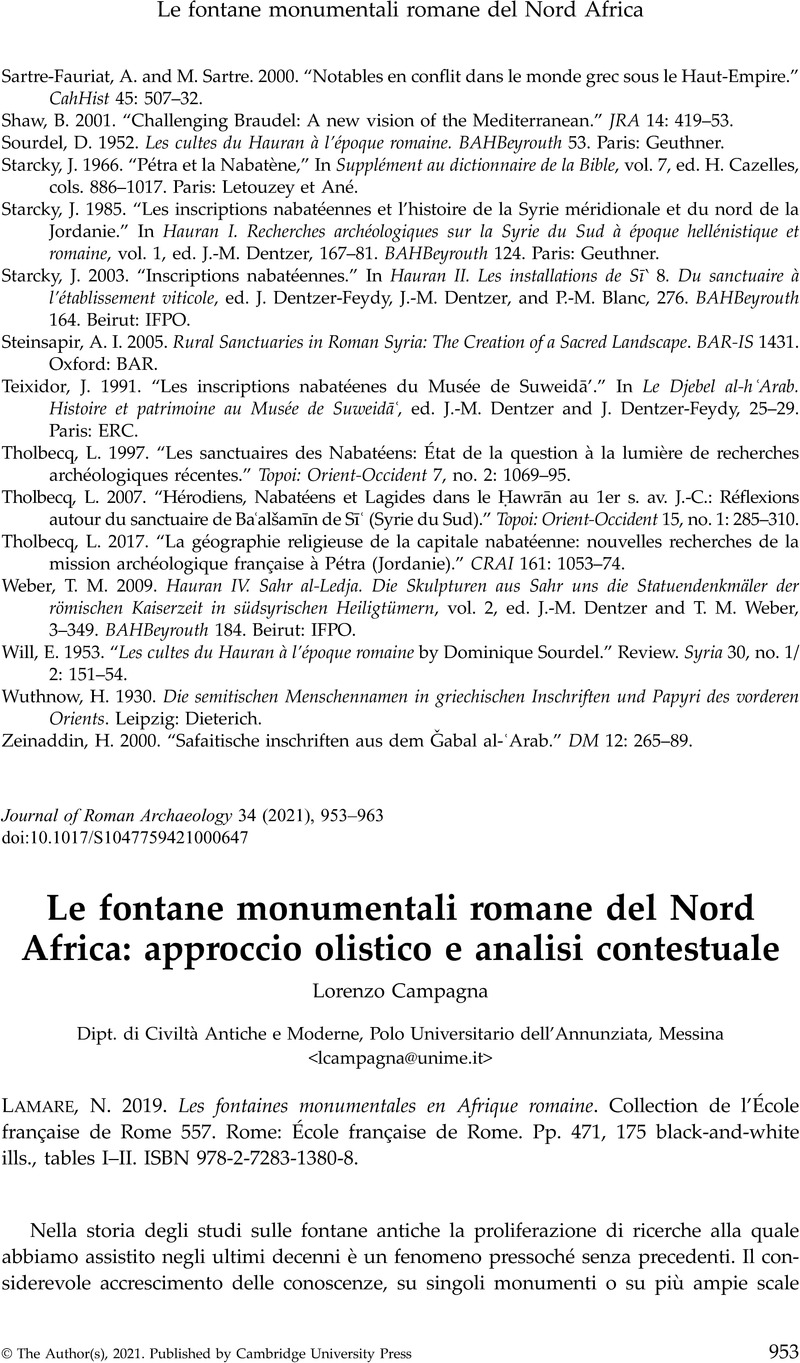Le fontane monumentali romane del Nord Africa: approccio olistico e analisi contestuale - N. Lamare 2019. Les fontaines monumentales en Afrique romaine. Collection de l’École française de Rome 557. Rome: École française de Rome. Pp. 471, 175 black-and-white ills., tables I–II. ISBN 978-2-7283-1380-8. | Journal of Roman Archaeology | Cambridge Core (original) (raw)
Abstract
An abstract is not available for this content so a preview has been provided. Please use the Get access link above for information on how to access this content.

References
Albertocchi, M. 2005. “La decorazione scultorea dei ninfei.” In Fontane e ninfei minori di Leptis Magna, ed. Tomasello, F., 157–82. Monografie di Archeologia Libica 27. Roma: L'Erma di Bretschneider.Google Scholar
Aristodemou, G. A., e Tassios, Th. P., eds. 2018. Aqueducts and Monumental Fountain Structures: Function in Context. Oxford: Archaeopress.Google Scholar
Aupert, P. 1974. Le nymphée de Tipasa et les nymphées et «septizonia» nord-africains. CÉFR 16. Roma: École française de Rome.Google Scholar
Berns, Ch. 2002. “Frühkaiserzeitliche Tabernakelfassaden. Zum Beginn eines Leitmotivs urbaner Architektur in Kleinasien.” In Patris und Imperium. Kulturelle und politische Identität in den Städten der römischen Provinzen Kleinasiens in der frühen Kaiserzeit, Kolloquium Köln 1998, ed. Berns, Ch., von Hesberg, H., Vandeput, L., and Waelkens, M., 159–74. BABesch Supplement 8. Leuven: Peeters.Google Scholar
Campagna, L. 2011. “ΤΟΥ ΥΔΑΤΟΣ ΔΩΡΕΑ (AE 2004, 1409): considerazioni sull'evergetismo dell'acqua nelle province dell'Asia Minore.” MedAnt 15, n˚ 1/2: 203–24.Google Scholar
Del Chicca, F. 1997. “Terminologia delle fontane pubbliche a Roma: Lacus, Salientes, Munera.” Rivista di cultura classica e medioevale 39, n˚ 2: 231–53.Google Scholar
Desnier, J.-L. 1993. “Omnia et realia. Naissance de l’Urbs sacra sévérienne (193–204 ap. J.-C.).” MÉFRA 105: 547–620.Google Scholar
Dorl-Klingenschmid, C. 2001. Prunkbrunnen in kleinasiatischen Städten. Funktion im Kontext. München: Pfeil.Google Scholar
Duval, N., e Lamare, N.. 2012. “Une petite ville romaine de Tunisie. Le municipium Cincaritanum.” MÉFRA 124: 231–88.Google Scholar
Ghiotto, A. R. 1999. “Ornatissimi lacus, munera, nymphaea. Le fontane monumentali pubbliche di Roma nella loro evoluzione lessicale.” Antenor 1: 71–90.Google Scholar
Ginouvès, R. 1969. “Le Nymphée de Laodicée et les nymphées romains.” In Laodicée du Lycos. Le Nymphée. Campagnes 1961–1963, eds. Wiseman, J., De Gagniers, J., Devambez, P., Kahil, L., Ginouvès, R., Robert, L., e Planhol, X., 136–67. Québec: Presses de l'Université Laval.Google Scholar
Gliwitzky, C. 2010. Späte Blüte in Side und Perge. Die pamphylische Bauornamentik des 3. Jahrhunderts n. Chr. Bern-New York: Peter Lang.Google Scholar
Jacobs, I., e Richard, J.. 2012 “‘We surpass the beautiful waters of other cities by the abundance of ours’: reconciling function and decoration in Late Antique fountains.” Journal of Late Antiquity 5: 3–71.10.1353/jla.2012.0000CrossRefGoogle Scholar
Jung, K. 2006. “Das Hydrekdocheion des Gaius Laecanius Bassus in Ephesos.” In Cura Aquarum in Ephesus. Proceedings of the Twelfth International Congress on the History of Water Management and Hydraulic Engineering in the Mediterranean Region, ed. Wiplinger, G., 79–86. Leuven: Peeters.Google Scholar
Lamare, N. 2016. “Architecture et motif littéraire de la fontaine, Orient-Occident.” In Parure monumentale et paysage dans la poésie épigraphique de l'Afrique romaine. Recueil de Carmina Latina Epigraphica, ed. Hamdoune, Chr., 263–73. Scripta Antiqua 85. Bordeaux: Ausonius éditions.Google Scholar
Lamare, N. 2017. “La fontaine à cour et l'hydraulique tardive de Sbeïtla. Nouvelles observations,” AntAfr 53: 95–114.10.4000/antafr.644CrossRefGoogle Scholar
Lamare, N. 2018. “Le nymphée disparu du capitole de Cirta. A propos de ILAlg, II, 1, 483.” In L'eau dans les villes su Maghreb et leur territoire à l’époque romaine, eds. Brouquier-Reddé, V. e Hurlet, F., 311–27. Bordeaux: Ausonius éditions.Google Scholar
Lavagne, H. 1988. Operosa antra. Recherches sur la grotte à Rome de Sylla à Hadrien. BÉFAR 272. Roma: École française de Rome.10.3406/befar.1988.1259CrossRefGoogle Scholar
Letzner, W. 1990. Römische Brunnen und Nymphaea in der westlichen Reichshälfte. Charybdis 2. Münster: Lit.Google Scholar
Longfellow, B. 2011. Roman Imperialism and Civic Patronage: Form, Meaning, and Ideology in Monumental Fountain Complexes. Cambridge-New York: Cambridge University Press.Google Scholar
Maischberger, M. 2009. “Das Nymphäum.” In ZeitRäume. Milet in Kaiserzeit und Spätantike. Ausstellung der Antikensammlung und des Deutschen Archäologischen Instituts im Pergamonmuseum auf der Berliner Museumsinsel, 6. Mai 2009–10. Januar 2010, eds. Dally, O., Maischberger, M., Schneider, P., ed Scholl, A., 104–107. Regensburg: Schnell & Steiner.Google Scholar
Mastino, A. 2018. “Neptunus Africanus: a note.” In Cartagine. Studi e Ricerche 3: 177–96.Google Scholar
Meschini, S. 1963. “Ninfei e fontane.” In Enciclopedia dell'Arte Antica, Classica e Orientale 5: 505–12.Google Scholar
Neuerburg, N. 1965. L'architettura delle fontane e dei ninfei nell'Italia antica. Memorie dell'Accademia di archeologia, lettere e belle arti di Napoli 5. Napoli: G. Macchiaroli Editore.Google Scholar
Portale, E. C. 2011. “Ancora sulla Kelsiane Bibliotheke di Efeso.” MedAnt 15, n˚ 1–2: 107–48.Google Scholar
Richard, J. 2011. “In the elites’ toolkit. Decoding the initiative and reference system behind the investment in the architecture and statuary programs of Roman nymphaea.” Facta 5: 65–100.Google Scholar
Richard, J. 2012. Water for the City, Fountains for the People. Monumental Fountains in the Roman East: An Archaeological Study of Water Management. Studies in Eastern Mediterranean Archaeology 9. Turnhout: Brepols.Google Scholar
Richard, J. 2016. “Where do we go now? The archaeology of monumental fountains in the Roman and early Byzantine East.” In Fountains and Water Culture in Byzantium, eds. Shilling, B. e Stephenson, P., 15–35. Cambridge: Cambridge University Press.10.1017/CBO9781316226742.002CrossRefGoogle Scholar
Ruggeri, P., e Ganga, S.. 2020. “Il tempio di Nettuno a Thignica e la colonizzazione di Thugga e Thubusicum Bure sotto Gallieno.” In L'epigrafia del Nord Africa: novità, riletture, nuove sintesi, eds. Aounallah, S. ed Mastino, A., 73–91. Faenza: Fratelli Lega editori.Google Scholar
Sandoz, C. 2008. “Le Grand Nymphée de Leptis Magna: étude historiographique, urbanistique et architecturale.” PhD diss., Univ. Paris-Sorbonne-Univ. de Lausanne.Google Scholar
Schmölder-Veit, A. 2009. Brunnen in den Städten des westlichen Römischen Reiches. Palilia 19. Wiesbaden: Reichert.Google Scholar
Settis, S. 1973. “‘Esedra’ e ‘ninfeo’ nella terminologia architettonica del mondo romano: dall'età repubblicana alla tarda antichità.” ANRW 1, n˚ 4: 601–745.Google Scholar
Wiegand, Th. 1919. “Zur Entwicklung der antiken Brunnenarchitektur.” In Milet V.1. Das Nymphaeum, 73–88. Berlin: G. Reimer Verlag.Google Scholar